Aid workers seek to avoid coronavirus outbreak at Matamoros migrant camp
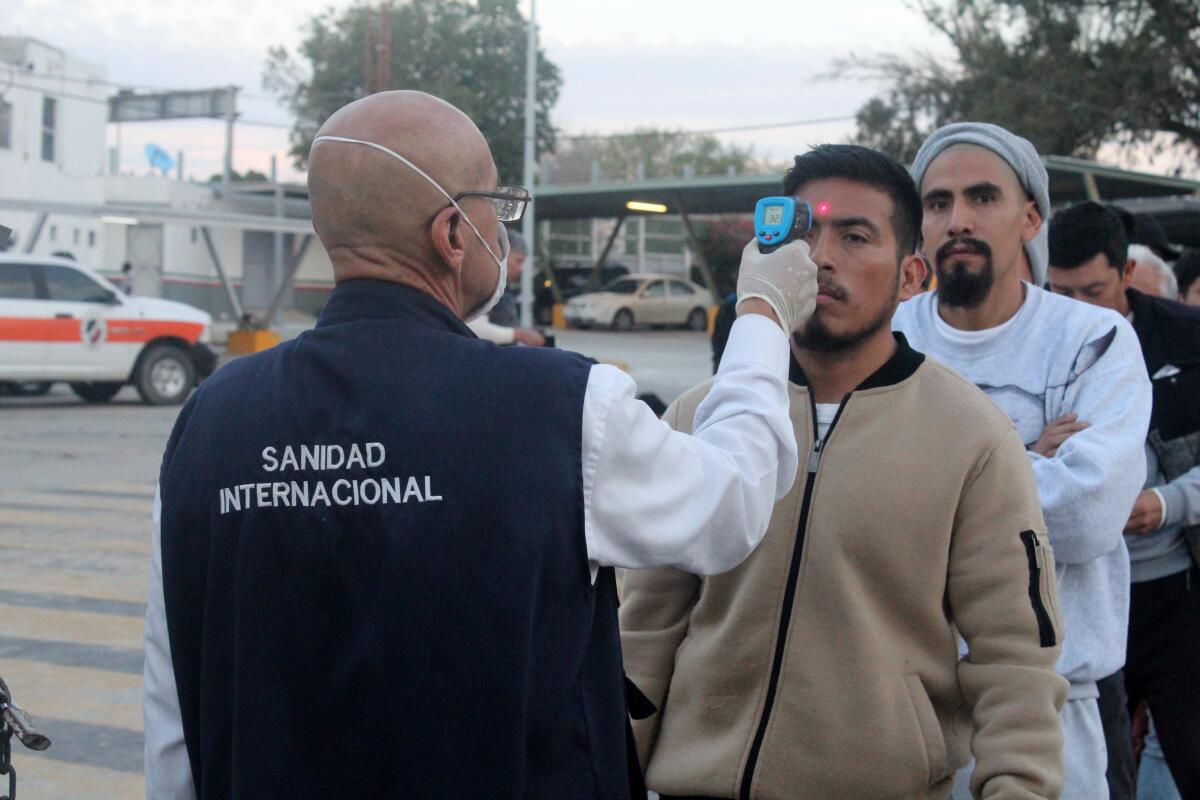
- Share via
MATAMOROS, Mexico — Scores of tents are pitched side by side, some home to as many as six people.
Residents wash at communal showers and sinks, line up in tight queues for evening meals, and gather after dark to socialize and sing evangelical melodies.
Smoke from campfires and swirling dust nurture colds, coughing jags and a wide range of other respiratory ailments.
The rudimentary conditions faced by some 2,000 asylum-seekers camped out here along the Rio Grande have long been denounced as an appalling tableau, just 100 yards from the border with Brownsville, Texas.
But now a deadly new threat is casting a dark shadow.
“The overcrowding here obviously increases the possibility of an outbreak of COVID,” said Valerio Granello of Doctors Without Borders, the international humanitarian group.
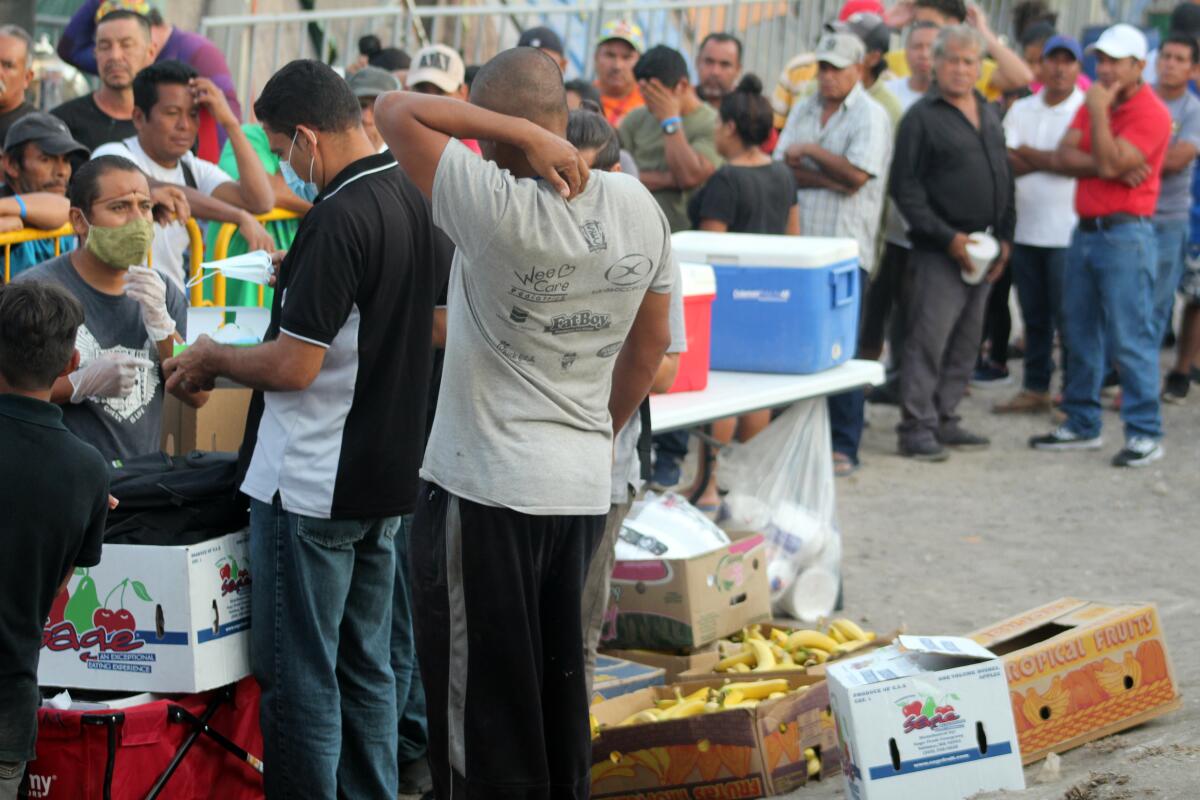
To date, only a handful of camp inhabitants have been tested for the coronavirus, and there has not been a single confirmed case among the mostly Central Americans and Mexicans seeking political asylum in the United States.
Many have been stuck here for months, sitting it out while their cases remain virtually moribund in U.S. immigration courts as part of the Trump administration’s Migrant Protection Protocols, informally known as Remain in Mexico.
The pandemic has prompted U.S. authorities to suspend hearings for those waiting in Mexico until at least May 1. There is no end in sight to the prolonged process.
The marooned migrants are extremely vulnerable, health professionals say, at a moment when much of the world is under lockdown. Physicians fear that an outbreak may be inevitable, likely requiring evacuation and isolation of many if not most camp dwellers. It is unclear where any migrant stricken with coronavirus would be taken.
“There is a great risk for an outbreak of coronavirus here,” said Dairon Elisondo Rojas, a Cuban doctor (and also a U.S. asylum applicant) with Global Response Management, a Florida-based nonprofit that is one of the few aid organizations still on site since U.S. and Mexican officials shut down “nonessential” cross-border traffic last month.
Signs posted throughout the camp urge migrants to wash their hands frequently, to maintain personal distances, to expand spaces between tents. But those safeguards are mostly aspirational in this densely populated squatterville, despite the recent installation of 16 additional hand-washing stations with dispensers of sanitizing gel.
Each resident may come in contact with as many as 50 people a day, health workers say. Hunkering down 24-7 in sweltering tents in the subtropical heat is not an option, especially for children. To minimize gatherings, school sessions have been canceled. That has only intensified the daily tedium.
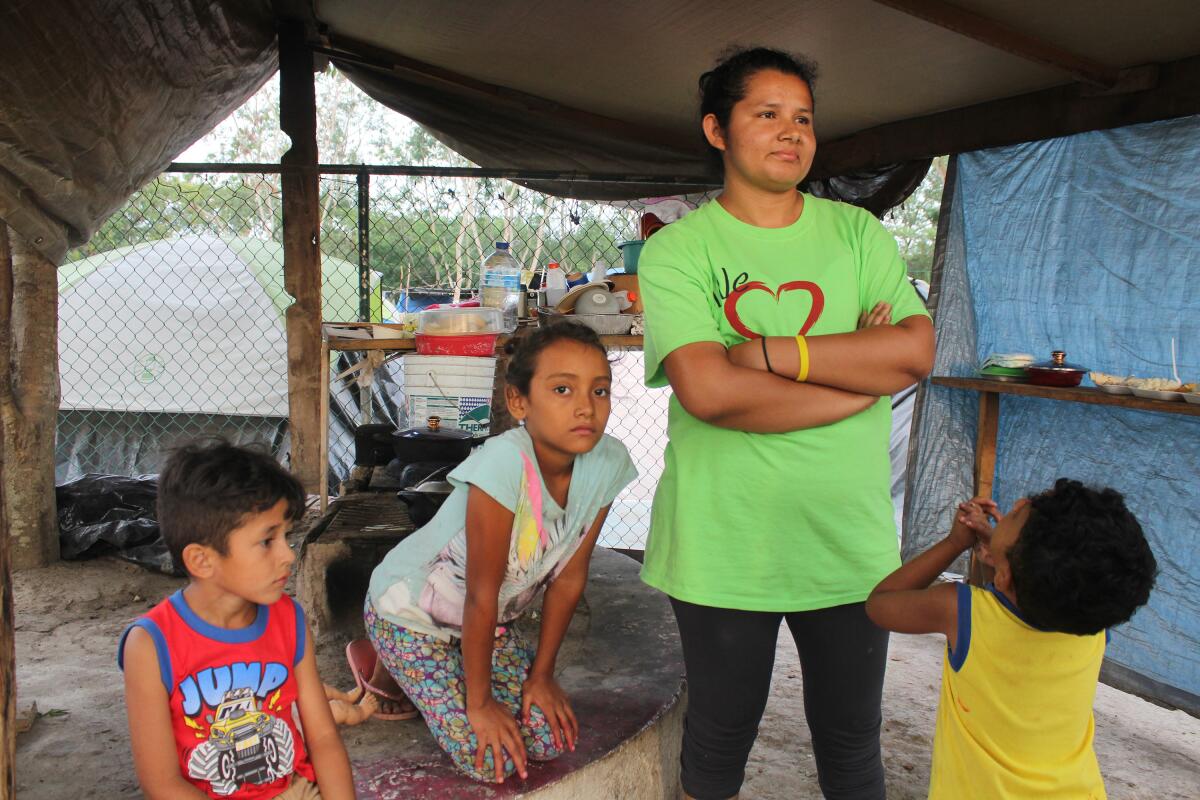
“We do what we can to be as hygienic as possible, to keep ourselves busy,” said Ana Antúnez, 26, a mother of three from Honduras, as she and other residents congregated by a campfire on a recent afternoon, keeping an eye on children darting amid the tents and brush. “But we are very limited in these kinds of conditions. We are all fearful of this disease.”
The majority here are women and children. Most are relatively young, which may provide some defense from the deadliness of a virus that appears to attack the elderly and those suffering underlying conditions with particular vehemence.
To date, the city of Matamoros, home to more than 500,000, has confirmed six cases of the coronavirus. Mexico’s Tamaulipas state, which includes Matamoros, has a total of 30 confirmed cases, with one fatality, a 54-year-old diabetic woman who succumbed on Thursday in the general hospital in the nearby border city of Reynosa.
By contrast, neighboring Texas had reported more than 6,110 cases and 105 deaths as of Saturday midday.
The disparity, experts say, likely reflects Mexico’s even lower testing rate than that across the border.
Antúnez arrived here in December after traversing Central America and Mexico with her two sons, aged 4 and 6. The family’s destination is Florida, where her husband resides with the couple’s daughter, Dunia, 9.
They gathered at dawn in this railyard in southern Mexico, contemplating their next move: catching a ride on the roof of La Bestia (The Beast) — the name migrants use for the notorious freight train that winds its way through Mexico toward the United States.
Advocates have called on the Trump administration to reduce the threat of infection by permitting tens of thousands of stranded asylum-seekers — from Matamoros on the Gulf of Mexico to Tijuana on the Pacific — to await court hearings with relatives in the United States. That would provide a safer alternative, advocates argue, than cramming into tents, cheap hotels and rental flats in dangerous Mexican border towns.
“The U.S. government is pushing people who are in the process of seeking asylum, including children, to live in unhygienic conditions that unnecessarily increase their risk of contracting the coronavirus,” said Ariana Sawyer, border researcher at Human Rights Watch.
But allowing migrants to await adjudications in the United States seems extremely unlikely, given President Trump’s hostility to immigration coupled with anxieties about the spread of the virus.
The asylum-seekers must remain in Mexico until their petitions are decided on a case-by-case basis, U.S. authorities insist. A cornerstone principle of Trump’s immigration crackdown is to end “catch and release” policies that, the administration argues, allowed many bogus asylum-seekers to enter U.S. territory.
Antúnez, who said her family fled gang violence in Honduras, attended an initial hearing in an immigration tent court in Brownsville on Feb. 26; a follow-up is scheduled for June 25. She has thus far resisted Mexico’s offer of a free bus trip back almost 1,000 miles to the border with Guatemala.
“I’m very concerned that we could all be infected by staying here,” Antúnez said. “But my major concern now is to see my daughter again, to be with my family. So for now I will stay.”
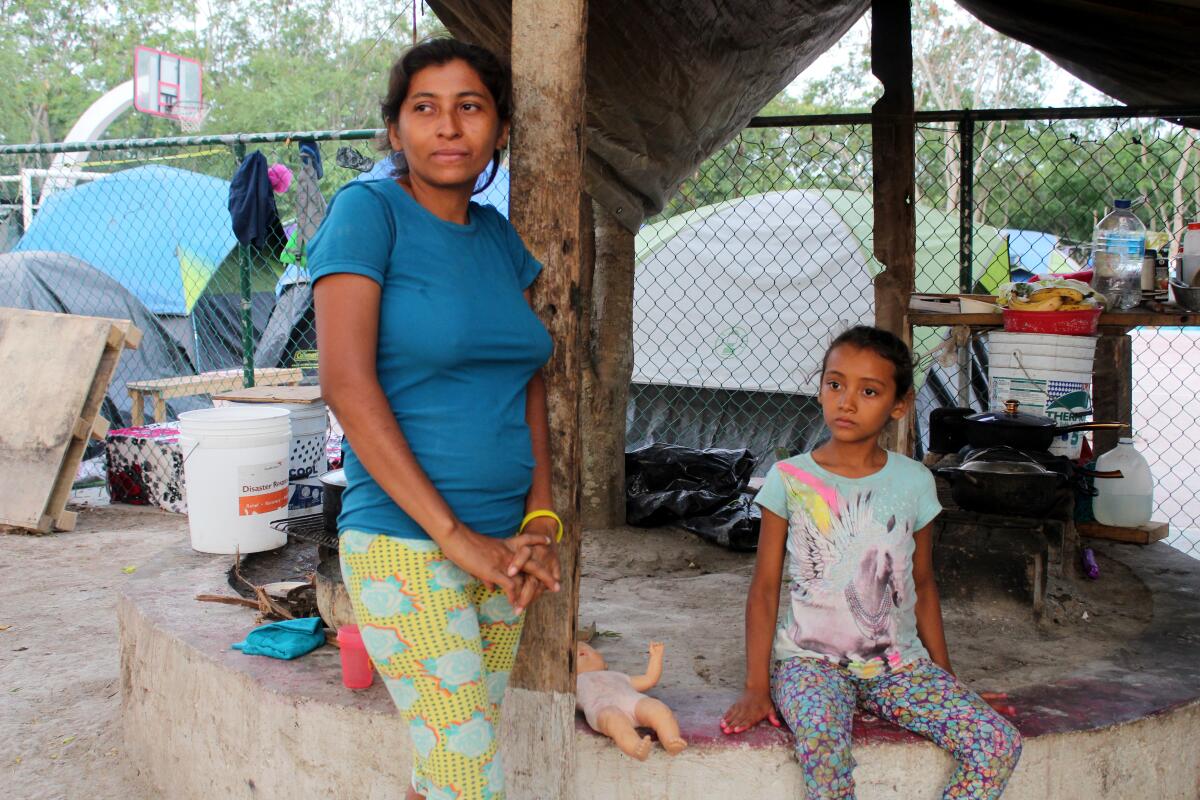
Antúnez’s neighbor, Migdalia Hernández, arrived from El Salvador in October with an infant daughter and her 10-year-old girl. She has a hearing scheduled for April 23 — but that is slated to be pushed back as part of Washington’s response to the coronavirus.
“I’ll wait here until I need to, despite the virus,” said Hernández, 30, who hopes to be reunited with loved ones in northern California. “At this point,” she added, “we are all in God’s hands.”
Doctors Without Borders provides psychological counseling for those struggling with multiple issues — squalid living conditions, separation from families, uncertain fates and the ominous prospect of the pandemic.
The camp, which has the feel of a Latin American village, is situated just south of the international bridge to Brownsville. The normally traffic-jammed bridge and bustling immigration complexes on both sides are now eerily quiet, becalmed outposts in times of coronavirus.
Camp conditions have improved slightly in recent months, as Mexico moved residents off the bridge approaches and onto this dusty, half-mile river-side strip, beneath stands of pine and mesquite.
Tents coexist with sometimes elaborate kitchens and dining areas crafted of branches topped with plastic sheets. Women cook tortillas and rice on wood-fire grills situated on blocks of stone or bricks or atop washing-machine drums salvaged from junkyards and employed as braziers. Mexican authorities fill abundant shared water vats, collect the trash and provide electricity for lighting posts and a cellphone charging station, which is among the site’s most popular hangouts. A shop sells basics like water and soft drinks, while donated clothing is dispensed from a makeshift storefront.
Occasional bike-riders navigate the dirt track flanking the camp, while joggers trot on a nearby river levee.
There are showers for personal bathing and sinks for washing clothing, while big-top tarpaulins provide some cover for rows of pitched tents. Port-o-potties serve as toilets. Men kick soccer balls on a pair of cement basketball courts. Drying garments strung from ubiquitous clotheslines flutter in the breeze.
No fence hems in the site. People are free to come and go. But few seem to venture far, except for basic shopping and U.S. court appearances. Wandering afield poses a danger: Matamoros, like other Mexican border towns, is a hub for extortion gangs that regularly kidnap migrants and demand ransoms from U.S. relatives, under threat of death.
On a recent visit here, few camp residents were wearing masks — with the notable exception of a pair of barbers, themselves Central American migrants, who meticulously served clients beneath the shade of pine trees. Their jobs preclude social distancing.
In recent weeks, the plethora of U.S. aid groups that once provided clothing, food and legal counseling has largely evaporated. Legal advice can only be found via phone, so fewer people have lawyers for their often-complex cases, greatly reducing their chances of attaining asylum. The remaining contingent of international aid staffers typically stays in Matamoros.
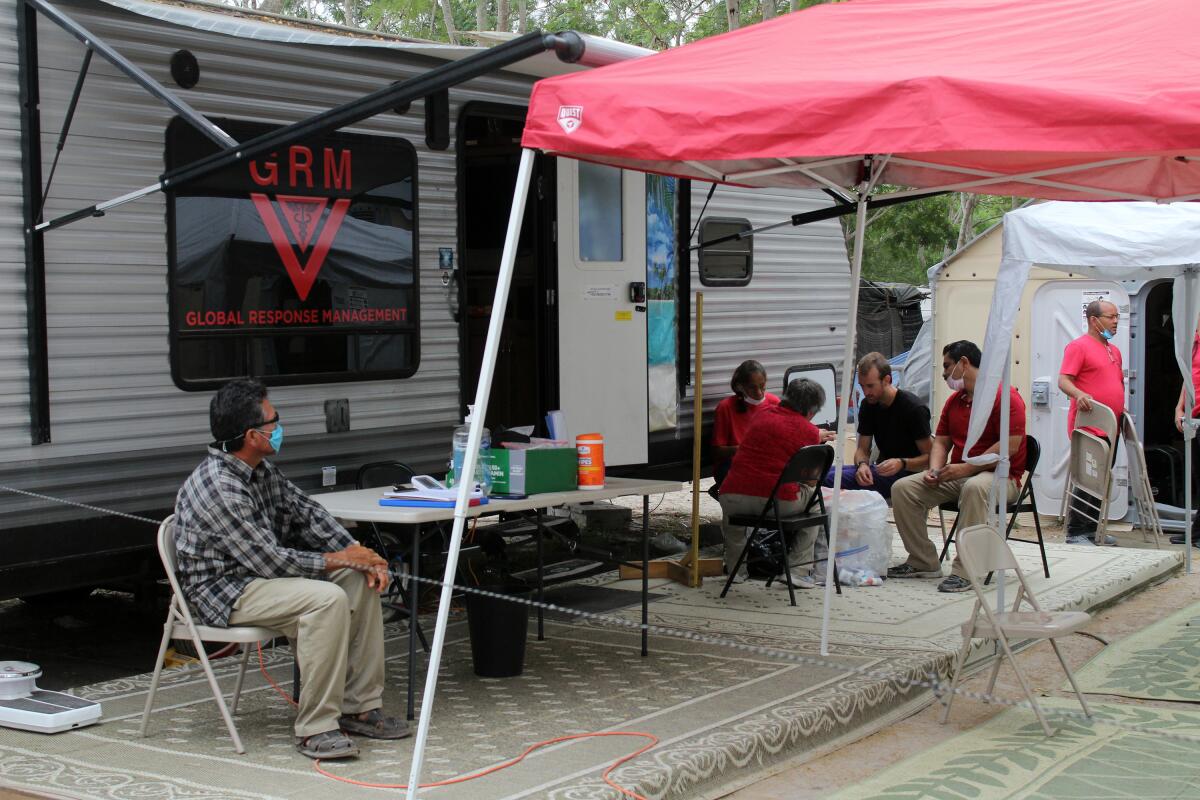
“No one wants to be the one who brings coronavirus to the camp,” noted Samuel Bishop, project coordinator here for Global Response Management, which has a support trailer on site.
Each day, Bishop noted, his group does random temperature tests on about 50 residents.
The nonprofit also plans to build a state-of-the-art, 20-bed field hospital, with intensive care capacity, ventilators and coronavirus testing kits, said Daniel Taylor, a board member of Global Response Management. The project awaits Mexican government approval.
Respiratory problems and skin irritations are the most common ailments among camp residents, doctors say.
Mexican authorities have long been eager to clear the camp, though they deny charges that residents have been coerced into leaving.
With the looming coronavirus threat, Mexican officials say they soon plan to relocate at least half the population to a stadium site about a mile away, where the migrants will have more space. Residents say they object to any move. For Mexican authorities, however, the specter of an outbreak has dramatized the urgency of reducing chronic overcrowding.
“They will be better taken care of” in the new facility, said Matamoros Mayor Mario Alberto López, who noted that the site would have “sanitary filters,” including temperature screening of everyone coming and going. “We need to check the entrances and exits so that someone doesn’t bring in an imported contagion.”
From the mayor’s standpoint, the migrants, some of whom have been squatting here for almost a year, should decide to either stay in Mexico and seek legal refugee status here, or return home to resume their lives.
“This situation has gone on for a long time already,” the mayor said. “I really don’t think the United States is going to give them visas.”
As the sun set one recent evening, a group of camp-dwellers sat on steps descending from the river levee and observed a near-daily spectacle: deported Mexican citizens being expelled to Mexico from the United States, where many had lived for years. A Mexican health inspector asked how long they had been in U.S. detention and deployed a pistol-like forehead thermometer emitting a red beam to take each returnee’s temperature.
“I certainly don’t want to be deported and up back here like these guys,” said Norma Baltazar, 37, an asylum-seeker from the violence-plagued western Mexican state of Guerrero.
“I want to go to the United States legally,” explained Baltazar, who was among the camp residents watching the doleful lines of returning deportees.
Like Antúnez, Baltazar said she hoped to be reunited with her divided family, including two daughters, aged 13 and 14, living with a sister in Victorville, California.
“Yes, I’m worried about the virus, we all are, but right now my goal is to be with my children again,” said Baltazar. “That’s my main preoccupation now, not coronavirus.”
Special correspondent Juan José Ramírez in Matamoros and Cecilia Sánchez in The Times’ Mexico City bureau contributed to this report.
More to Read
Sign up for Essential California
The most important California stories and recommendations in your inbox every morning.
You may occasionally receive promotional content from the Los Angeles Times.










